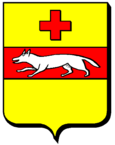Bouzonville
| Bouzonville | ||
|---|---|---|

|
|
|
| region | Grand Est | |
| Department | Moselle | |
| Arrondissement | Forbach-Boulay-Moselle | |
| Canton | Bouzonville (main town) | |
| Community association | Bouzonvillois-Trois Frontières | |
| Coordinates | 49 ° 18 ' N , 6 ° 32' E | |
| height | 192-310 m | |
| surface | 13.90 km 2 | |
| Residents | 3,947 (January 1, 2017) | |
| Population density | 284 inhabitants / km 2 | |
| Post Code | 57320 | |
| INSEE code | 57106 | |
 Heilig Kreuz abbey building on the high bank of the Nied |
||
Bouzonville ( German Busendorf , Lorraine Busendroff ) is a French commune with 3947 inhabitants (as of January 1, 2017) in the Moselle department in the Grand Est region (until 2015 Lorraine ). It belongs to the Forbach-Boulay-Moselle arrondissement and is the capital of the canton of Bouzonville . The inhabitants call themselves Bouzonvillois .
geography
The small town of Bouzonville is located on the banks of the Nied in the Niedland (Pays de Nied) , about 18 kilometers west of Saarlouis and 30 kilometers east of Thionville .
The districts of Heckling , Benting and Aidling belong to Bouzonville .
history
In 1033 the Counts of Metz founded a Benedictine abbey here. The place itself is mentioned in a document in 1106 as Buosonis villa . The German form of the name appears in 1176 as a Bosendorph . The personal name Boso is in the final word. Occasionally, King Boso of Vienne is named as the namesake of the place , who had a country house built here.
In 1766 Bouzonville came to the Kingdom of France with the Duchy of Lorraine . After the Franco-Prussian War of 1870/1871 and the subsequent Peace of Frankfurt on May 10, 1871, Bouzonville was part of the newly founded German Empire as a place in the realm of Alsace-Lorraine . Bouzonville was separated from the German Empire by the Treaty of Versailles . In the years 1926–1939 the area was shaped by the construction of the French Maginot Line . From 1940 until the Allied reconquest in 1944 it was again occupied by Germans and belonged to the Gau Westmark .
Population development
| year | 1962 | 1968 | 1975 | 1982 | 1990 | 1999 | 2007 | 2014 |
| Residents | 3,306 | 3,763 | 4,232 | 4,285 | 4.148 | 4.117 | 4.178 | 3,970 |
Worth seeing
- The monastery church of the former abbey of Sainte-Croix de Bouzonville (Abbey of the Holy Cross) is a transeptless Gothic pseudo-basilica with an open porch. In the baroque period the tower was given a Welsche hood. The choir stalls with figural carvings come from the Baroque period. The end of the chancel of the church has two choir flank towers typical of Lorraine. The central nave is 17 m high, the side aisles reach a height of 10 m. People and animals appear in the leaf capitals of the pillars of the triumphal arch. The keystones of the vaults show several noble and abbot coats of arms in addition to the Easter lamb .
partnership
Since 1979 there has been a community partnership with the neighboring Saarland community of Rehlingen-Siersburg .
Personalities
- Louis Hackspill (1871–1945), MP
- Max Stiff (1890–1966), District Administrator in Hildesheim from 1922 to 1925, District Administrator in Münster from 1929 to 1933
traffic
The Bouzonville station lies on the railway line Völklingen-Thionville and the railway Dillingen-Bouzonville .
Web links
- Bouzonville website (French)
Individual evidence
- ↑ Printed by Georges Boulangé: Les sépultures Lorraines à Bouzonville . In: L'Austrasie , Metz 1855, pp. 331–354; here p. 343 ff.
- ↑ Uwe Anhäuser: Lothringen, Between Vosges and Champagne, on Maas and Mosel, Cologne 1998, p. 79.
- ↑ Uwe Anhäuser: Lothringen, Between Vosges and Champagne, on Maas and Mosel, Cologne 1998, p. 44.




